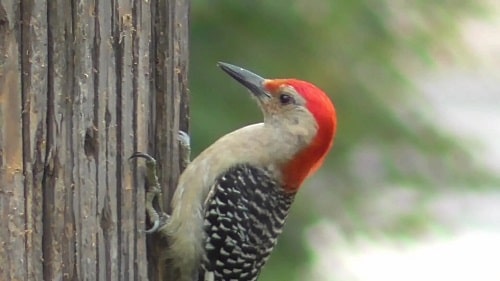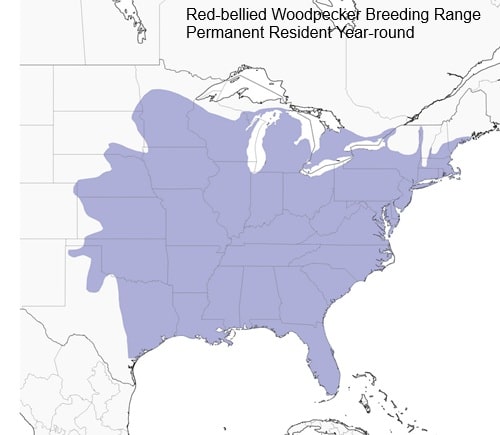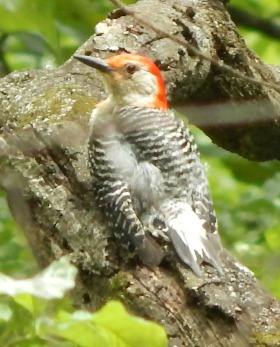Red-bellied Woodpecker Nesting Habits, Diet, Call, and Breeding Season
Description: Size - Field Marks
Novice birders may confuse the Red-bellied with the Red-headed Woodpecker, but their differences are striking.
The male Red-bellied measures about 9 inches with a wingspread of about 17 inches.
He has bands of black and white on his back referred to as a "ladder back."

You can easily identify him by his vibrant red forehead, crown, and nape. The breast and face are a dull gray.
The difference between the female Red-bellied Woodpecker and the male is the amount of red on each.
The female is similar to the male but has red only on the nape and above the bill. Her crown is gray.
The Red-bellied Woodpecker is named for a small quarter-sized patch of reddish tint on the belly, sometimes difficult to see but easier if you watch them at your feeders.
Juveniles don't have any red on their heads, and their markings are less contrasting, giving them a grayer appearance compared to the grown-ups.
You'll notice that their bills are a browner shade.
Mating - Breeding Habits
The Red-bellied Woodpecker is found across most of the eastern United States and continues expanding northward, adapting to suburban and wooded landscapes alike.

Similar to all woodpeckers, the Red-bellied uses drumming as the primary source for attracting and communicating with potential mates.
This habit of drumming may be done on hollow limbs, gutters, siding, utility poles, or any other material that it finds resonates well for its needs.
Much to the dismay of the person who wishes to "sleep in" on weekends or the night shift worker.

Do They Mate for Life?
Considered monogamous throughout the breeding season.
Some Red-bellied Woodpeckers may form pair bonds lasting over several seasons, but they are not considered as mating for life.
An unusual part of courtship with this woodpecker species is mutual tapping.
Generally done at a potential nesting cavity, one bird will enter as the other stays outside and each will take turns tapping to the other.
Breeding activity occurs at the time of pair formation, which is as early as January-February. Eggs are laid in late April in most areas.
In Southern states such as Alabama and Texas as late as July.
Most late nests seen in northern states are most likely re-nesting attempts due to the failure of the first nest. Florida has had egg laying as late as August.
Nesting Habits
Both male and female Red-bellies will build their nest in a tree, (dead or decaying) a utility pole, or take over another species of woodpecker home.
Red-bellied Woodpeckers will also nest in man-made birdhouses
Each season, a new cavity is excavated but may be in the same tree. Not unusual to see 3 or 4 cavities on a single limb in a row.
The imported European Starling usurps the nesting cavities of Red-bellied Woodpeckers.
Studies have shown that 50 percent of nest cavities are taken by Starlings, which reduces the clutch sizes of the woodpeckers.
The female will lay 4 - 5 pure white eggs. One egg is laid each day until the clutch is complete.
Incubation (gestation period is not a term used with birds) is done by both birds and begins after the last egg is laid and will last about 12 - 14 days.
The baby birds will fly from the nest (fledge) in about 24 - 27 days after hatching.
| Breeding and Nesting Timeline | |
|---|---|
| Breeding Season | Late Jan. - Feb. |
| Nest Building | Late Mar. - Apr. |
| Eggs | 4 - 5 |
| Incubation | 12 - 14 days |
| Nestling Phase | 24 - 27 days |
| Broods | 1 - 2 |
The adults divide the young between them and the young continue to depend on and follow the adults for 5 to 6 weeks.
After this post-fledging training, the male will drive the young from the territory.
In the north, a single brood may be raised each season while in the south two and even (rarely) three broods may be raised.
Territorial Call
The Red-bellied's rolling "chur-chur-chur" call echoes through woods and neighborhoods. Males use it to claim territory and court females.
Listen below to a typical territorial call.
Feeding Habits - Diet What they Eat
Red-bellied Woodpeckers are not rare and will readily visit winter bird feeders if suet is offered.
In Spring, a fruit feeder with orange halves will bring them closeup.
These Woodpeckers cache food in bark crevices, vine rootlets, and other places that require no excavation.
While they do store food, they don't do it at the level of most other woodpeckers. They're able to find food year-round.
Other items that can be offered at the home feeding station are peanut butter, sunflower seed, and cracked corn.
In the wild, Red-bellied Woodpeckers eat a diet of mainly vegetable matter consisting of a variety of tree nuts such as beechnuts, hickory nuts, and acorns.
Other foods include seeds, beetles, insect larvae, tree frogs, and fruit.
They are also known for eating the eggs and young of other birds, whether in open cup nests or nests in tree cavities.
Conservation Status
East of the Rockies, the Red-bellied Woodpecker is widespread and fairly common in backyards with older trees.
In southern states, this woodpecker has been around for a long time and has been expanding northward and into the central plains.
While not a rare woodpecker, habitat destruction and competition with non-native species like European Starlings reduces populations.
The Red-bellied Woodpecker is listed as Least Concern by the IUCN, with populations increasing thanks to warmer winters and adaptation to suburban habitats.
Leaving standing dead trees or providing woodpecker nest boxes can greatly improve their breeding success in your area.
Do They Migrate?
Red-bellied Woodpeckers are considered permanent residents in most areas. There are some southward movements from those that breed in the northernmost areas.
These woodpeckers are sensitive to cold weather extremes. However, warmer temperatures are believed to contribute to its northern expansion.
Predators
Predators that attack eggs and nestlings are rat snakes, Pileated Woodpeckers, Starlings, Red-headed Woodpeckers, and flying squirrels (southern).
Adults and fledglings have Coopers Hawk, Sharp-shinned Hawk, Rat snakes, and Starlings as predators.








